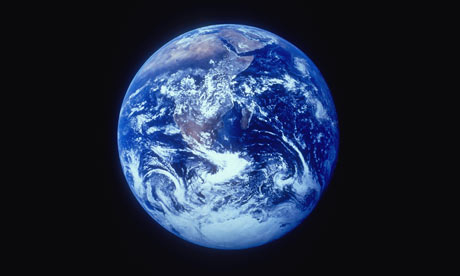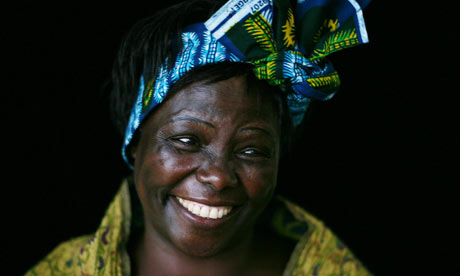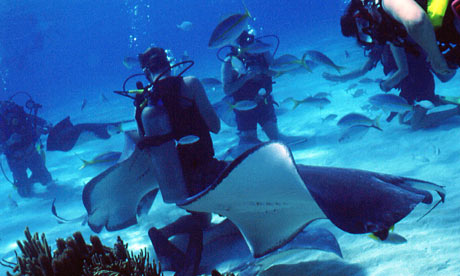Martin Rees
The Guardian,

What does the future hold for our small blue planet and its inhabitants? Photograph: Blue Line Pictures/Getty Images
It would be foolhardy to venture technological predictions for 2050. Even more so to predict social and geopolitical changes. The most important advances, the qualitative leaps, are the least predictable. Not even the best scientists predicted the impact of nuclear physics, and everyday consumer items such as the iPhone would have seemed magic back in the 1950s.
But there are some trends that we can predict with confidence. There will, barring a global catastrophe, be far more people on Earth than today. Fifty years ago the world population was below 3 billion. It has more than doubled since then, to 6.7 billion. The percentage growth rate has slowed, but it is projected to reach 9 billion by 2050. The excess will almost all be in the developing world where the young hugely outnumber the old.
If population growth were to continue beyond 2050, one can't be other than exceedingly gloomy about the prospects. And the challenge of feeding such a rapidly growing population will be aggravated by climate change.
The world will be warmer than today in 2050; the patterns of rainfall and drought across the world will be different. If we pursue "business as usual",
CO2 concentration levels will reach twice the pre-industrial level by around 2050. The higher its concentration, the greater the warming - and, more important still, the greater the chance of triggering something grave and irreversible: rising sea levels due to the melting of Greenland's icecap; runaway release of methane in the tundra.
Some technical advances - information technology, for instance - surprise us by their rapidity; others seemingly stagnate. Only 12 years elapsed between the launch of Sputnik and Neil Armstrong's "one small step" on the moon. Many of us then expected a lunar base, even an expedition to Mars, within 30 years. But it's more than 36 years since Jack Schmitt and Eugene Cernan, the last men on the moon, returned to Earth. Since that time, hundreds of astronauts have been into orbit, but none has ventured further.
The Apollo programme now seems a remote historical episode: young people all over the world learn that America landed men on the moon, just as they learn that the Egyptians built the pyramids; the motivations seem almost as bizarre in the one case as in the other. The race to the moon was an end in itself - a magnificent "stunt", driven by superpower rivalry. Thereafter, the impetus for manned flight was lost. But, of course, we now depend on space in our everyday lives (GPS, weather forecasting and communications). And robotic exploration has burgeoned. Unmanned probes to other planets have beamed back pictures of varied and distinctive worlds.
I hope that by 2050 the entire solar system will have been explored and mapped by flotillas of tiny robotic craft. Robots and "fabricators" may enable large construction projects, using raw materials that need not come from Earth. But will people follow them? The practical case for sending people into space gets ever-weaker with each advance in robots and miniaturisation. But I'm nonetheless an enthusiast for manned missions - to the moon, to Mars and even beyond - simply as a long-range adventure for (at least a few) humans.
Each mobile phone today has far more computing power than was available to the whole of Nasa in the 1960s. And advances proceed apace. Some claim that computers will, by 2050, achieve human capabilities. Of course, in some respects they already have. For 30 years we've been able to buy calculators that can hugely surpass us at arithmetic. IBM's "Deep Blue" beat Kasparov, the world chess champion. But not even the most advanced robot can recognise and move the pieces on a real chessboard as adeptly as a five-year-old child.
Deep Blue didn't work out its strategy like a human player: it exploited its computational speed to explore millions of alternative series of moves and responses before deciding an optimum move. Likewise, machines may make scientific discoveries that have eluded unaided human brains - but by testing out millions of possibilities rather than via a theory or strategy.
But will we continue to push forward the frontiers, enlarging the range of our consensual understanding? Some aspects of reality - a unified theory of physics, or a theory of consciousness - might elude our understanding simply because they're beyond the powers of human brains, just as surely as quantum mechanics would flummox a chimpanzee.
We can with some confidence predict continuing advances in computer power, in IT, in techniques for sequencing and interpreting and modifying the genome. But there could, by 2050, be qualitatively new kinds of change. For instance, one thing that's been unaltered for millennia is human nature and human character. But in this century, mind-enhancing drugs, genetics, and "cyborg" techniques may start to alter human beings themselves.
And we should keep our minds open, or at least ajar, to concepts on the fringe of science fiction. Flaky American futurologists aren't always wrong. They remind us that a superintelligent machine is the last instrument that humans may ever design - the machine will itself take over in making further steps. Another speculation is that the human lifespan could be greatly extended, something that would wreak havoc on all population projections. At the moment this hope leads some to bequeath their bodies to be "frozen" on their death, in the hope of some future resurrection. For my part, I'd still opt to end my days in an English churchyard rather than a Californian refrigerator.
We can make one firm forecast that's important for all "citizen scientists". There will surely be a widening gulf between what science enables us to do, and what applications it's prudent or ethical to pursue.
It's sometimes wrongly imagined that astronomers, contemplating timespans measured in billions, must be serenely unconcerned about next year, next week and tomorrow. But a "cosmic perspective" actually strengthens my own concerns about the here and now.
Ever since Darwin, we've been familiar with the stupendous timespans of the evolutionary past. But most people still somehow think we humans are necessarily the culmination of the evolutionary tree. No astronomer could believe this.
Our sun formed 4.5bn years ago, but it's got 6bn more before the fuel runs out. And the expanding universe will continue - perhaps for ever - becoming ever colder, ever emptier. As Woody Allen said, "Eternity is very long, especially towards the end". Any creatures who witness the sun's demise, here on Earth or far beyond, won't be human. They will be entities as different from us as we are from a bug.
But even in this "concertinaed" timeline - extending millions of centuries into the future, as well as into the past - this century is special. It's the first in our planet's history where one species - ours - has Earth's future in its hands, and could jeopardise not only itself, but life's immense potential.
Suppose some aliens had been watching our planet for its entire history. Over nearly all that immense time - 4.5bn years - Earth's appearance would have altered very gradually. But in just a tiny sliver of its history - the last few thousand years - the patterns of vegetation altered much faster than before. This signalled the start of agriculture. The pace of change accelerated as human populations rose.
Then there were other changes, even more abrupt. Within the last 50 years - little more than one hundredth of a millionth of the Earth's age - the carbon dioxide in the atmosphere began to rise anomalously fast. The planet became an intense emitter of radio waves (TV, cellphone, and radar transmissions.) And something else unprecedented happened: small projectiles launched from the planet escaped the biosphere. Some were propelled into orbits around the Earth; some journeyed to the moon and planets.
If they understood astrophysics, the aliens could confidently predict that the biosphere would face doom in a few billion years when the sun flares up and dies. But could they have predicted this unprecedented spike less than halfway through the Earth's life - these human-induced alterations occupying, overall, less than a millionth of the elapsed lifetime and seemingly occurring with runaway speed?
If they continued to keep watch, what might these hypothetical aliens witness in the next few decades? Will final spasm be followed by silence? Or will the planet itself stabilise? And will some of the objects launched from the Earth spawn new oases of life elsewhere?
The outcome depends on political choices. But those choices can be influenced by effective and idealistic scientists, environmentalists and humanists, guided by the knowledge and technology that the 21st century will offer.



